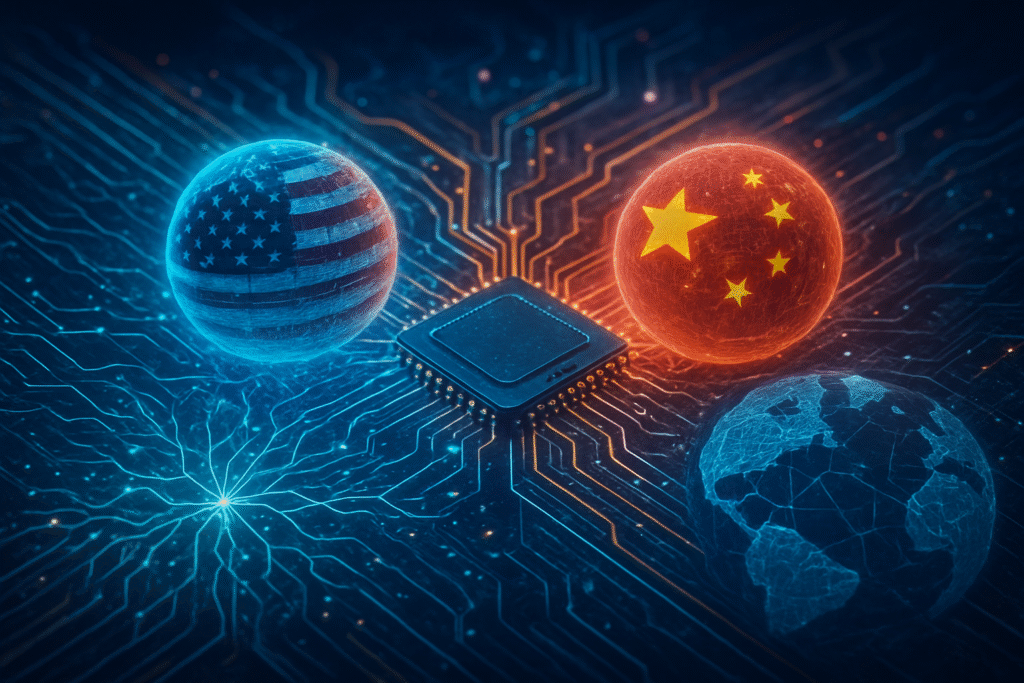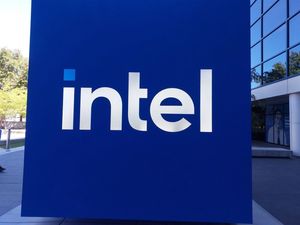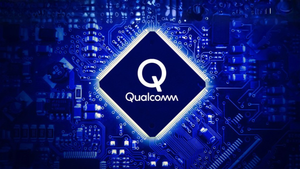
The United States and China are locked in an escalating semiconductor showdown, a geopolitical struggle that by late 2025 has profoundly reshaped global technology and supply chains. This intense competition, often dubbed an "AI Cold War," frames advanced semiconductors as the foundational assets for national security, economic dominance, and the future of artificial intelligence. The rivalry is accelerating technological decoupling, pushing nations towards self-sufficiency and creating a bifurcated global technology market where strategic resilience often trumps economic efficiency.
This high-stakes contest is characterized by meticulously targeted US export controls designed to impede China's access to cutting-edge computing capabilities and sophisticated manufacturing equipment. Beijing, in turn, is responding with massive state-led investments and an aggressive drive for indigenous innovation, leveraging its own strategic advantages, such as dominance in rare earth elements. The immediate significance lies in the pronounced fragmentation of the global semiconductor ecosystem, leading to increased costs, supply chain vulnerabilities, and a fundamental reorientation of the tech industry worldwide.
The Technical Frontline: Export Controls, Indigenous Innovation, and the Quest for Nano-Supremacy
The US-China chip rivalry is a deeply technical battleground, where advancements and restrictions are measured in nanometers and teraFLOPS. As of late 2025, the United States has progressively tightened its export controls on advanced AI chips and manufacturing equipment, aiming to limit China's ability to develop cutting-edge AI applications and military technologies. The US Department of Commerce's Bureau of Industry and Security (BIS) has established specific technical thresholds for these restrictions, targeting logic chips below 16/14nm, DRAM memory chips below 18nm half-pitch, and NAND flash memory chips with 128 layers or more. Crucially, AI chips with a Total Processing Performance (TPP) exceeding 4800, or a TPP over 2400 and a performance density greater than 1.6, are blocked, directly impacting advanced AI accelerators like Nvidia Corporation (NASDAQ: NVDA)'s H100/H200. These regulations also encompass 24 types of chip manufacturing equipment and three software programs, with the Foreign Direct Product Rule (FDP) now applying regardless of the percentage of US components, potentially halting expansion and operations at Chinese chip factories. In January 2025, a global AI Diffusion Rule was introduced to prevent China from accessing advanced AI chips and computing power via third countries.
China, viewing restricted access as a vulnerability, is aggressively pursuing an all-Chinese supply chain under initiatives like "Made in China 2025." Huawei's HiSilicon division has emerged as a significant player with its Ascend series of AI accelerators. The Ascend 910C, fabricated using SMIC (HKEX: 0981)'s 7nm N+2 process, reportedly achieves around 800 TFLOP/s at FP16 and delivers approximately 60% of Nvidia H100's inference performance, especially with manual optimizations. It features 128GB of HBM3 memory with about 3.2 TB/s bandwidth. Huawei is also reportedly trialing its newest Ascend 910D chip, expected in late 2025, aiming to rival Nvidia's H100 with an anticipated 1200 TFLOPS. China plans to triple AI chip output, with Huawei-dedicated fabrication facilities beginning production by year-end 2025.
The gold standard for advanced chip manufacturing remains Extreme Ultraviolet (EUV) lithography, monopolized by Dutch firm ASML Holding N.V. (NASDAQ: ASML), which has been banned from selling these machines to China since 2019. China is investing heavily in indigenous EUV development through companies like Shanghai Micro Electronics Equipment (SMEE), reportedly building its first EUV tool, "Hyperion-1," for trial use by Q3 2025, though with significantly lower throughput than ASML's machines. Chinese researchers are also exploring Laser-induced Discharge Plasma (LDP) as an alternative to ASML's light source. Furthermore, SiCarrier, a Huawei-linked startup, has developed Deep Ultraviolet (DUV)-based techniques like self-aligned quadruple patterning (SAQP) to extend older DUV machines into the 7nm range, a method validated by the domestically manufactured 7nm chip in Huawei's Mate 60 Pro smartphone in 2023. This ingenuity, while impressive, generally results in lower yields and higher costs compared to EUV.
This current rivalry differs from previous tech competitions in its strategic focus on semiconductors as a "choke point" for national security and AI leadership, leading to a "weaponization" of technology. The comprehensive nature of US controls, targeting not just products but also equipment, software, and human capital, is unprecedented. Initial reactions from the AI research community and industry experts, as of late 2025, are mixed, with concerns about market fragmentation, increased costs, and potential slowdowns in global innovation. However, there is also an acknowledgment of China's rapid progress in domestic chip production and AI accelerators, with companies already developing "China-compliant" versions of AI chips, further fragmenting the market.
Corporate Crossroads: Navigating a Bifurcated Tech Landscape
The US-China chip rivalry has created a complex and often contradictory landscape for AI companies, tech giants, and startups globally, forcing strategic re-evaluations and significant market adjustments by late 2025.
On the Chinese side, domestic firms are clear beneficiaries of Beijing's aggressive self-sufficiency drive. AI chipmakers like Huawei Technologies Co., Ltd. (SHE: 002502) (through its HiSilicon division), Semiconductor Manufacturing International Corporation (HKEX: 0981), Cambricon Technology Corporation (SSE: 688256), and startups like DeepSeek and Moore Threads are receiving substantial government support and experiencing surging demand. Huawei, for instance, aims to double its computing power each year through its Ascend chips, with targets of 1.6 million dies by 2026. Chinese tech giants such as Tencent Holdings Ltd. (HKEX: 0700), Alibaba Group Holding Limited (NYSE: BABA), and Baidu, Inc. (NASDAQ: BIDU) are actively integrating these domestically produced chips into their AI infrastructure, fostering a burgeoning local ecosystem around platforms like Huawei's CANN.
Conversely, US and allied semiconductor companies face a dual challenge. While they dominate outside China, they grapple with restricted access to the lucrative Chinese market. Nvidia Corporation (NASDAQ: NVDA), despite its global leadership in AI accelerators, has seen its market share in China drop from 95% to 50% due to export controls. Advanced Micro Devices, Inc. (NASDAQ: AMD) is gaining traction with AI accelerator orders, and Broadcom Inc. (NASDAQ: AVGO) benefits from AI-driven networking demand and custom ASICs. Major US tech players like OpenAI, Microsoft Corporation (NASDAQ: MSFT), Google (NASDAQ: GOOGL), and Amazon.com, Inc. (NASDAQ: AMZN) are making massive capital expenditures on AI infrastructure, driving immense demand for advanced chips. Foundries like Taiwan Semiconductor Manufacturing Company Limited (NYSE: TSM) remain critical, expanding globally to meet demand and de-risk operations, while Intel Corporation (NASDAQ: INTC) is re-emerging as a foundry player, leveraging CHIPS Act funding.
The competitive implications are stark. US AI labs and tech giants maintain a lead in breakthrough AI model innovation, backed by private AI investment reaching $109.1 billion in the US in 2025, far outstripping China's. However, scaling AI infrastructure can face delays and higher costs. Chinese AI labs, while facing hardware limitations, have demonstrated remarkable "innovation under pressure," optimizing algorithms for less powerful chips and developing advanced AI models with lower computational costs, such as DeepSeek's R1 model, which rivaled top US open-source models at a fraction of the training cost.
The rivalry disrupts existing products and services through increased costs, supply chain inefficiencies, and potential performance compromises for Chinese companies forced to use less advanced solutions. US chip designers face significant revenue losses, and even when allowed to sell modified chips (like Nvidia's H20), Chinese officials discourage their procurement. The weaponization of critical technologies and rare earth elements, as seen with China's October 2025 export restrictions, introduces significant vulnerabilities and delays in global supply chains.
Strategically, US firms leverage technological leadership, private sector dynamism, and government support like the CHIPS Act. Chinese firms benefit from state-backed self-sufficiency initiatives, a focus on "AI sovereignty" with domestically trained models, and algorithm optimization. Global players like TSMC and Samsung Electronics Co., Ltd. (KRX: 005930) are strategically diversifying their manufacturing footprint, navigating the complex challenge of operating in two increasingly distinct technological ecosystems. The outcome is a fragmented global technology landscape, characterized by increased costs and a strategic reorientation for companies worldwide.
A New Global Order: Beyond Bits and Bytes
The US-China chip rivalry transcends mere technological competition, evolving by late 2025 into a full-spectrum geopolitical struggle that fundamentally reorders the global landscape. This "AI Cold War" is not just about microchips; it's about control over the very infrastructure that powers the 21st-century economy, defense, and future industries.
This contest defines the broader AI landscape, where control over computing power is the new strategic oil. The US aims to maintain its lead in advanced AI chip design and manufacturing, while China aggressively pursues technological self-sufficiency, making significant strides in indigenous AI accelerators and optimizing algorithms for less powerful hardware. The increasing demand for computational power to train ever-larger AI models makes access to high-performance chips a critical determinant of AI leadership. US export controls are designed to keep China behind in high-end chip production, impacting its ability to keep pace in future AI development, despite China's rapid progress in model development.
The impacts on global supply chains are profound, leading to accelerated "decoupling" and "technonationalism." Companies are implementing "China +1" strategies, diversifying sourcing away from China to countries like Vietnam and India. Both nations are weaponizing their strategic advantages: the US with sanctions and export bans, and China with its dominance in rare earth elements, critical for semiconductors. China's expanded export controls on rare earths in October 2025 underscore its willingness to disrupt global supply chains, leading to higher costs and potential production slowdowns for chipmakers. Europe, dependent on US chips and Chinese rare earths, faces significant vulnerabilities in its own AI ambitions.
Concerns span security, economics, and ethics. National security drives US export controls, aiming to curb China's military modernization. China, in turn, harbors security concerns about US chips potentially containing tracking systems, reinforcing its push for indigenous alternatives. Economically, US sanctions have caused revenue losses for American chipmakers, while the bifurcated market leads to increased costs and inefficiencies globally. The controversial 15% revenue cut for the US government on certain AI chip sales to China, allowed in August 2025, raises legal and ethical questions about national security versus financial gain. Ethically, the underlying AI competition raises concerns about the potential for AI to be used for surveillance, repression, and autonomous weapons.
This rivalry is viewed in "epochal terms," akin to a new Sputnik moment, but focused on silicon and algorithms rather than nuclear arms. It's a pivotal moment where critical technologies are explicitly weaponized as instruments of national power. Geopolitically, the competition for AI sovereignty is a battle for the future of innovation and global influence. Taiwan, home to TSMC (NYSE: TSM), remains a critical flashpoint, manufacturing 90% of advanced AI chips, making its stability paramount. The rivalry reshapes alliances, with nations aligning with one tech bloc, and China's "Made in China 2025" initiative aiming to reshape the international order. The long-term impact is a deeply fragmented global semiconductor market, where strategic resilience and national security override economic efficiency, leading to higher costs and profound challenges for global companies.
The Road Ahead: Forecasts for a Fractured Future
Looking ahead, the US-China chip rivalry is set to intensify further, with both nations continuing to pursue aggressive strategies that will profoundly shape the future of technology and global relations. As of late 2025, the trajectory points towards a sustained period of competition and strategic maneuvering.
In the near term, the US is expected to continue refining and expanding its export controls, aiming to close loopholes and broaden the scope of restricted technologies and entities. This could include targeting new categories of chips, manufacturing equipment, or even considering tariffs on imported semiconductors. The controversial revenue-sharing model for certain AI chip sales to China, introduced in August 2025, may be further refined or challenged. Simultaneously, China will undoubtedly redouble its efforts to bolster its domestic semiconductor industry through massive state investments, talent development, and incentivizing the adoption of indigenous hardware and software. We can expect continued progress from Chinese firms like Huawei and SMIC in their respective areas of AI accelerators and advanced fabrication processes, even if they lag the absolute cutting edge. China's use of export controls on critical minerals, like rare earth elements, will likely continue as a retaliatory and strategic measure.
Long-term developments foresee the clear emergence of parallel technology ecosystems. China is committed to building a fully self-reliant tech stack, from materials and equipment to design and applications, aiming to reduce its dependency on imports significantly. While US restrictions will slow China's progress in the short to medium term, they are widely predicted to accelerate its long-term drive towards technological independence. For US firms, the long-term risk is that Chinese companies will eventually "design out" US technology entirely, leading to diminished market share. The US, through initiatives like the CHIPS Act, aims to control nearly 30% of the overall chip market by 2032.
Potential applications and use cases will be heavily influenced by this rivalry. Both nations are vying for AI supremacy, with high-performance chips being crucial for training and deploying complex AI models. The competition will extend to quantum computing, next-generation AI chips, and 5G/6G technologies, with China pushing for global agreement on 6G standards to gain a strategic advantage. Advanced semiconductors are also critical for military applications, digital infrastructure, and edge computing, making these areas key battlegrounds.
Challenges abound for both sides. The US must maintain its technological edge while managing economic fallout on its companies and preventing Chinese retaliation. China faces immense technical hurdles in advanced chip manufacturing without access to critical Western tools and IP. Globally, the rivalry disrupts supply chains, increases costs, and pressures allied nations to balance competing demands. Experts predict a continued technological decoupling, intensified competition, and a relentless pursuit of self-sufficiency. While China will likely lag the absolute cutting edge for several years, its capacity for rapid advancement under pressure should not be underestimated. The "chip war" is embedded in a broader techno-economic rivalry, with 2027 often cited as a pivotal year for potential increased tensions, particularly concerning Taiwan.
The Unfolding Narrative: A Summary and Forward Look
As of late October 2025, the US-China chip rivalry stands as a monumental force reshaping the global technological and geopolitical landscape. The key takeaway is a fundamental shift from a globally integrated, efficiency-driven semiconductor industry to one increasingly fragmented by national security imperatives and strategic competition. The US has weaponized export controls, while China has responded with a relentless, state-backed pursuit of technological self-reliance, demonstrating remarkable ingenuity in developing indigenous AI accelerators and optimizing existing hardware.
This development is of paramount significance in AI history, defining the contours of an "AI Cold War." It directly impacts which nation will lead in the next generation of AI innovation, influencing everything from economic prosperity to military capabilities. The long-term impact points towards a bifurcated global technology ecosystem, where resilience and strategic control supersede pure economic efficiency, leading to higher costs and duplicated efforts. This means that for the foreseeable future, companies and nations worldwide will navigate two distinct, and potentially incompatible, technological stacks.
In the coming weeks and months, several critical indicators bear watching. Any new US policy directives on chip exports, particularly concerning advanced AI chips and potentially new tariffs, will be closely scrutinized. China's progress in scaling its domestic AI accelerator production and achieving breakthroughs in advanced chip manufacturing (e.g., SMIC's 5nm-class chips) will be vital benchmarks. The ongoing impact of China's rare earth export controls on global supply chains and the continued adjustments by multinational companies to de-risk their operations will also provide insights into the evolving dynamics. Finally, the degree of cooperation and alignment among US allies in semiconductor policy will be crucial in determining the future trajectory of this enduring strategic competition. The silicon schism is far from over, and its reverberations will continue to shape the global order for years to come.
This content is intended for informational purposes only and represents analysis of current AI developments.
TokenRing AI delivers enterprise-grade solutions for multi-agent AI workflow orchestration, AI-powered development tools, and seamless remote collaboration platforms.
For more information, visit https://www.tokenring.ai/.







